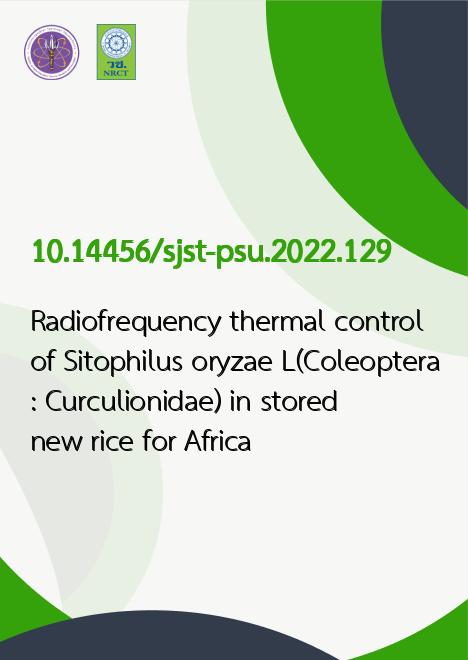
|
Radiofrequency thermal control of Sitophilus oryzae L.(Coleoptera: Curculionidae) in stored new rice for Africa |
|---|---|
| รหัสดีโอไอ | |
| Creator | 1. Agbesi Kwadzo Keteku 2. Suchada Dana |
| Title | Radiofrequency thermal control of Sitophilus oryzae L.(Coleoptera: Curculionidae) in stored new rice for Africa |
| Publisher | Research and Development Office, Prince of Songkla University |
| Publication Year | 2565 |
| Journal Title | Songklanakarin Journal of Science an Technology (SJST) |
| Journal Vol. | 44 |
| Journal No. | 4 |
| Page no. | 971-978 |
| Keyword | NERICA, insect control, Sitophilus oryzae, radiofrequency thermal, temperature, tolerance |
| URL Website | https://rdo.psu.ac.th/sjst/index.php |
| ISSN | 0125-3395 |
| Abstract | Insect pest control in stored agricultural produce has mainly been done by chemical fumigation in sub-Saharan Africa.The demand for human and environmentally safe foods has made this practice unacceptable, making the search for non-chemicalalternatives a global research priority. The impact of radio frequency (RF) heat treatment was studied on the variousdevelopmental growth phases of Sitophilus oryzae in stored New Rice for Africa (NERICA). After exposure to 27.12 MHz RF at50 ยฐC for 3 min, only the egg stage recorded 100% mortality. The adult stage of the weevil was the most RF tolerant, butnonetheless, 100% mortality was achieved after exposure to 27.12 MHz RF at 55 ยฐC for 4 min. For economic energymanagement, taking into consideration the economic strength of farmers, exposure to 27.12 MHz RF at 60ยฐC for 3 min was themost energy-efficient, consuming as little as 0.462 KWh energy to completely kill S. oryzae. Analysis of the quality parametersof the rice after exposure to 27.12 MHz RF at 60ยฐC for 3 min revealed no significant quality changes in moisture, protein, freefatty acid, and ash contents. The results have provided a vivid basis for the development and use of RF treatment as a nonchemical energy-efficient alternative for controlling S. oryzae in NERICA. RF control could be the needed technical post-harvestprotection approach, considering its low labour involvement, minimum energy requirement, and cost-effectiveness, needed topropel Ghana and Sub-Saharan Africa to become competitive in the global rice industry. |
